Report on Post-Conflict Forensic Challenges in Gaza and Implications for Sustainable Development Goals
Introduction: Ceasefire Aftermath and Humanitarian Crisis
- Following a ceasefire agreement, Israeli authorities have returned 195 bodies to Gaza in exchange for the remains of 13 Israeli hostages and two foreign nationals returned by Hamas.
- This exchange has precipitated a significant forensic and humanitarian challenge at Gaza’s Nasser hospital, directly impacting the region’s capacity to uphold principles of justice and health outlined in the Sustainable Development Goals (SDGs).
Forensic Capacity and Infrastructure Deficits: A Challenge to SDG 3 and SDG 9
- The forensics team at Nasser hospital operates from a single room, lacking essential infrastructure such as DNA testing facilities and adequate cold storage units. This severely compromises their ability to conduct proper examinations, a critical failure in achieving **SDG 3 (Good Health and Well-being)**, particularly Target 3.d concerning health risk management.
- Dr. Ahmed Dheir, head of the unit, highlighted the critical lack of cold storage, stating, “If we wait for the bodies to thaw, rapid decomposition begins almost immediately, putting us in an impossible position [because] we lose the ability to examine the remains properly.”
- This lack of resilient infrastructure is a direct impediment to **SDG 9 (Industry, Innovation and Infrastructure)**, which calls for the development of reliable and sustainable facilities to support human well-being.
Allegations of Human Rights Violations and the Imperative for SDG 16 (Peace, Justice and Strong Institutions)
- Medical authorities in Gaza report that many bodies show signs of severe mistreatment, including decomposition, being naked or partially clothed, and having wrists tied.
- Dr. Alaa al-Astal of the Nasser hospital forensic team reported observing “signs of torture,” such as deep grooves from blindfolds and tissue damage from restraints that cut off blood circulation.
- Sameh Yassin Hamad, a member of the Hamas-run government committee, noted signs of severe beatings and stab wounds on some bodies.
- The state of the remains raises profound questions about adherence to international law and human rights, central tenets of **SDG 16**, which aims to reduce all forms of violence (Target 16.1) and promote the rule of law and equal access to justice (Target 16.3).
- International forensic experts, while noting the difficulty of reaching conclusions without post-mortems, have validated the concerns.
- Michael Pollanen, a forensic pathologist at the University of Toronto, described the situation as an “international forensic emergency,” emphasizing, “We need to know the truth behind how deaths occurred, and the only way to know the truth is to do autopsies.” This call for truth and accountability is fundamental to achieving **SDG 16**.
Systemic Issues and Institutional Accountability
- Evidence from human rights organizations suggests widespread abuse of detainees in Israeli custody. Naji Abbas of Physicians for Human Rights (PHRI) stated that detainees from Gaza were cuffed and blindfolded continuously for months, leading to serious infections.
- Reports from medics who worked at the Sde Teiman military facility confirm that detainees were kept in restraints even during medical procedures.
- These practices challenge the principles of **SDG 16**, which calls for effective, accountable, and transparent institutions at all levels. The difficulty in distinguishing between combatants and civilians among the returned bodies further complicates efforts to ensure accountability and justice.
Challenges in Identification and Information Sharing: Undermining Justice and Rule of Law (SDG 16)
- A significant barrier to justice is the failure to identify the deceased. Israel reportedly provided identification for only six of the 195 bodies, five of which were incorrect.
- Dr. Dheir stated, “Since these bodies were held by the Israeli authorities, they will have full data about them. But they haven’t shared that information with us.” This lack of information sharing obstructs the legal and humanitarian processes necessary for achieving justice.
- The Israeli military responded that “all bodies returned so far are combatants” and denied tying bodies prior to release, while the Prime Minister’s Office described the reports as “efforts to demonise Israel.”
- This impasse on information and accountability directly undermines the goal of ensuring equal access to justice for all, as stipulated in **SDG 16**.
Conclusion: The Human Cost and the Path Forward for Sustainable Development
- The inability to conduct proper forensic analysis and identification has a profound human cost, denying closure to families of the missing.
- Of the 195 bodies, only around 50 have been positively identified, forcing many families to bury unidentified remains.
- Houwaida Hamad, searching for her nephew, expressed the families’ distress: “If there was [DNA] testing, we’d know where he is – yes or no.”
- Achieving sustainable peace and development in the region, as envisioned by the SDGs, requires a foundational commitment to justice, human rights, and the strengthening of institutions. Addressing the current forensic crisis by providing necessary resources and ensuring transparent investigations is a critical step toward fulfilling the promise of **SDG 16 (Peace, Justice and Strong Institutions)**.
Analysis of Sustainable Development Goals in the Article
1. Which SDGs are addressed or connected to the issues highlighted in the article?
The article highlights issues that are directly and indirectly connected to several Sustainable Development Goals (SDGs). The primary goals addressed are:
- SDG 16: Peace, Justice and Strong Institutions: This is the most prominent SDG in the article. The text focuses on the aftermath of a conflict, the exchange of bodies, allegations of torture and mistreatment of detainees, the violation of international law, and the struggle for justice and accountability for the deceased. The lack of transparent processes and the inability of institutions (like the hospital’s forensics unit) to function effectively are central themes.
- SDG 3: Good Health and Well-being: The article extensively details the critical shortcomings of the health infrastructure in Gaza, specifically at Nasser hospital. The forensics team’s inability to perform its duties due to a lack of resources like cold storage and DNA testing facilities directly impacts public health management, particularly in identifying human remains and determining causes of death, which is a crucial health service in a post-conflict scenario.
- SDG 9: Industry, Innovation and Infrastructure: The challenges faced by the forensics team are rooted in a severe lack of essential infrastructure. The absence of “DNA testing facilities or cold storage units” is a clear indicator of a deficit in resilient and functional infrastructure required for basic institutional and health services.
2. What specific targets under those SDGs can be identified based on the article’s content?
Based on the issues discussed, the following specific SDG targets can be identified:
- Under SDG 16 (Peace, Justice and Strong Institutions):
- Target 16.1: Significantly reduce all forms of violence and related death rates everywhere. The article’s core subject is the investigation of deaths in a conflict setting, with forensic doctors examining bodies for “signs of torture,” “stab wounds,” and other injuries indicative of violence.
- Target 16.3: Promote the rule of law at the national and international levels and ensure equal access to justice for all. The call for proper post-mortems to “know the truth behind how deaths occurred,” the discussion of detainees held “without charge,” and the reference to actions being a “violation of international law” all point to the need for justice and the rule of law.
- Target 16.6: Develop effective, accountable and transparent institutions at all levels. The article highlights the failure of institutions to provide information, stating that Israeli authorities “haven’t shared that information with us through the Red Cross” regarding the identity and circumstances of death of the deceased.
- Target 16.9: By 2030, provide legal identity for all, including birth registration. In this context, the target extends to the legal identification of the deceased. The struggle to identify the 195 bodies returned, with only about 50 being identified, directly relates to this target’s principle of ensuring every individual has a legal identity from life to death.
- Under SDG 3 (Good Health and Well-being):
- Target 3.d: Strengthen the capacity of all countries… for early warning, risk reduction and management of national and global health risks. The inability of the Nasser hospital’s forensics unit to manage the mass casualty situation by performing autopsies and identifying bodies (“The situation is extremely challenging”) demonstrates a critical weakness in health risk management capacity.
- Under SDG 9 (Industry, Innovation and Infrastructure):
- Target 9.1: Develop quality, reliable, sustainable and resilient infrastructure… to support… human well-being. The article explicitly states the forensics team operates “with no DNA testing facilities or cold storage units of its own,” a clear failure of the necessary reliable and resilient infrastructure required for health and justice services.
3. Are there any indicators mentioned or implied in the article that can be used to measure progress towards the identified targets?
The article provides several explicit and implicit indicators that can measure progress:
- For Target 16.1 (Reduce violence):
- Indicator (Explicit): The number of conflict-related deaths. The article mentions “195 bodies have been returned to Gaza.”
- Indicator (Implied): The proportion of bodies showing signs of torture or mistreatment. The article describes “bruises and marks from binding,” “stab wounds,” and “deep grooves” from blindfolds, which could be systematically documented to measure this.
- For Target 16.3 (Rule of law):
- Indicator (Implied): The percentage of suspicious deaths that undergo a full medicolegal autopsy. The article notes the need for post-mortems but states they are not being performed due to a lack of facilities. An increase in this percentage would indicate progress.
- For Target 16.9 (Legal identity):
- Indicator (Explicit): The proportion of deceased individuals who are formally identified. The article provides clear numbers: “only some 50 bodies have been positively identified” out of 195 returned, and “54 have been buried, unidentified.” This creates a baseline rate of identification (approx. 25.6%).
- For Target 3.d (Health capacity):
- Indicator (Implied): The availability of essential forensic services in health facilities. The article states the hospital has “no DNA testing facilities or cold storage units.” The establishment of such facilities would be a direct measure of strengthened capacity.
4. Table of SDGs, Targets, and Indicators
| SDGs | Targets | Indicators Identified in the Article |
|---|---|---|
| SDG 16: Peace, Justice and Strong Institutions |
16.1: Significantly reduce all forms of violence and related death rates everywhere.
16.3: Promote the rule of law… and ensure equal access to justice for all. 16.9: By 2030, provide legal identity for all. |
– Number of conflict-related deaths (195 bodies returned). – Proportion of bodies with signs of torture or mistreatment (e.g., binding marks, bruises, stab wounds). – Percentage of suspicious deaths undergoing a full medicolegal autopsy (currently near zero). – Proportion of deceased individuals formally identified (approx. 50 out of 195 identified). |
| SDG 3: Good Health and Well-being | 3.d: Strengthen the capacity of all countries… for… management of national and global health risks. | – Availability of essential forensic services (e.g., cold storage, DNA testing) in key health facilities (currently none at the unit). |
| SDG 9: Industry, Innovation and Infrastructure | 9.1: Develop quality, reliable, sustainable and resilient infrastructure. | – Functional capacity of critical health infrastructure (forensics unit lacks cold storage and DNA testing facilities). |
Source: bbc.com






